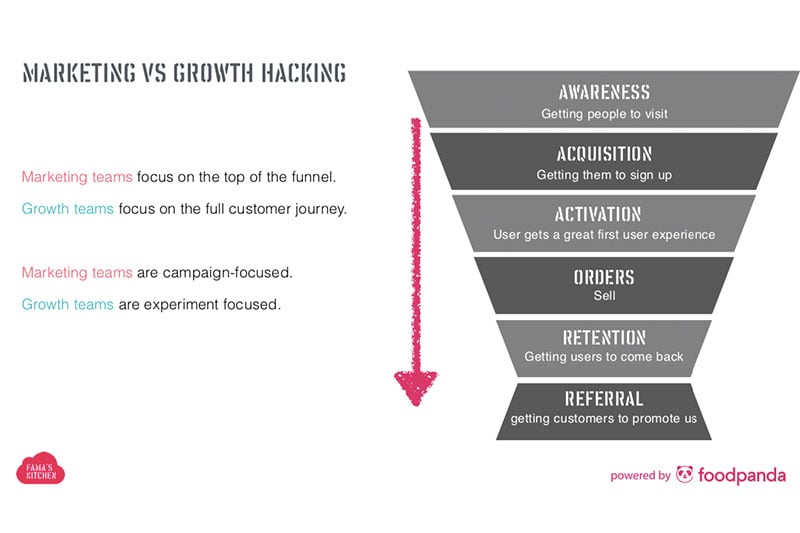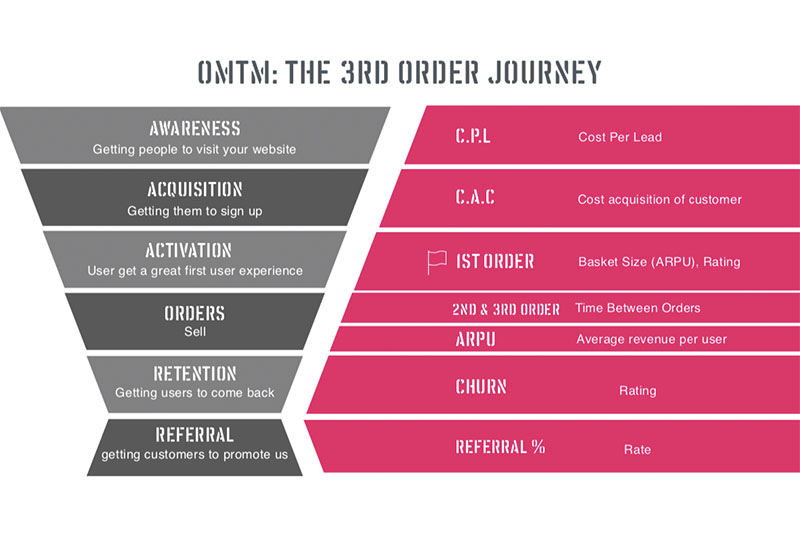It’s competitive out there. That’s why digital marketing guru Chi Tran is sharing the data-driven growth hacking techniques that could give you that edge you’re looking for.
Growth hacking is one of the buzziest marketing strategies of the moment, promising big results without the hefty price tag. Adopting alternative mediums including digital marketing, SEO, targeted advertising and social media marketing, it’s garnered a reputation for being bold and revolutionary. Presenting at Foodie’s Food’s Future Summit, Chi Tran, CEO of boutique digital agency Re:Start, former APAC CTO at advertising and marketing conglomerate Ogilvy and angel investor, talked through the data-driven results that he’s personally achieved with growth hacking in the F&B industry as the Co-Founder of Hong Kong-based organic food restaurant chain FAMA Group – and how these strategies could be a game-changer for other companies across Asia.

#1
Prioritise the whole customer journey – not just the sales funnel
Sometimes, the big picture is key. “Marketing teams focus on just the sales funnel. Growth teams focus on the full consumer journey,” explains Chi of the fundamental difference in approach he sees as vital.
When you look at a sales funnel, it ends at the conversion – i.e. when the consumer buys the product. But, there’s a better, more holistic model that takes it one step further, says Chi – what he calls the ‘Pirate Funnel,’ which consists of six steps: awareness, acquisition, activation, retention, revenue, referral (or ‘AAARRR’). Combine this with short iterations, and you’ve got a recipe for rapid growth.
“We look at all the measurements,” he explains. “And then we settle on one common goal, or what we say is the one metric that matters (OMTM). Would you look at reactivation? Or conversions? What is that one thing that we all want to work towards?”
#2
Increase the volume of your growth hacking experiments
Taking Twitter as a case study, Chi stresses how important it is to experiment constantly – and increase the volume of your experiments if you’re to see dramatic growth.
“When [Twitter] did five experiments a week, they started going to single-digit growth. The moment they got a new product manager, they went to 20, 30, 40 experiments a week, and then they saw themselves go from double-digit growth to exponential growth,” he explains. Drawing from concepts created by Amsterdam-based growth hacking academy Growth Tribe, he advocates a continuous cycle of data analysis, gathering ideas, ranking ideas, outlining experiments, and putting these into action.
Delving deeper into his past experiments, Chi illustrated how he saw retention rates spike substantially between a consumer’s first and second visit to FAMA Group restaurants (41% and 48%, respectively) and their third visit (75%). Building on this data, he then experimented with free delivery offers to “get them down that consumer journey” and increase loyalty among new customers. The outcome? The offer had the biggest impact on consumers buying orders of around HKD100 and a relatively small impact on customers ordering HKD350 worth of food.
You might also like 7 Tips for Business Success in Asia

#3
Leverage technology to help you scale faster
When it comes to optimisation, technology is your friend. And if you can drive costs down by using unconventional methods, it could give you just the edge you need to beat out your competitors.
One way Chi has used technology to his advantage is by testing out a cloud (or shared) kitchen model in his F&B ventures with FAMA Group – renting out fully-equipped, quick-serve commercial kitchens to deliver restaurant-level food which is ordered exclusively via an online system. “The reason we do a cloud kitchen is that we want to minimise food prices and automate it – we interface our ordering scheduling system directly with Foodpanda,” Chi elaborates. “In the longer term, the AI-based scheduling allows us to optimise; when the shift receives a certain amount of orders, we push it to the next station.” By collecting a database of order volumes, taste preferences, order frequency, and peak flow across time, the goal is to be able to continually refine their operational process to reduce costs and food waste while still offering a top-notch product to the consumer.
More broadly, artificial intelligence could be the key to optimisation across industries by reducing unnecessary inefficiencies. Already, we’re seeing deep learning technology being deployed in smart food waste systems; McKinsey reports that AI could help us save USD 127 billion by preventing food waste by 2030.
#4
Unlock the full value of the customer
Customer segmentation – and tailoring a firm’s value proposition to match the needs and problems of these demographics – is crucial to growth. With the advent of digital platforms, it’s now possible to create virtual brands targeted at more niche markets to attract new customers.
“As part of the cloud kitchen, we launched six brands within three months,” Chi states. These virtual brands range from ‘Selfish Bowl,’ a range of mid-priced customisable Korean poke bowls, to ‘Let’s Flick N Chill,’ a higher-end dining experience at home – think lobster rolls, caviar and champagne, and ‘Healthy Chinese,’ a more affordable version of tasty Chinese food with no-fuss meal sets available.
Each of these virtual brands targets a segment persona, allowing firms to establish a stronger product-market fit with their consumer base without needing to increase their brick and mortar costs. And it’s working – FAMA Group is looking to launch another six brands in the next month, with an end-goal of 18 brands.

#5
Don’t be afraid to get things wrong
At the end of the day, it’s all about experimentation. And sometimes that means getting things wrong. When asked if data has ever misled him, Chi answers, “Absolutely!”
Citing an example where he’d evaluated consumers that spend about HKD 250 per order, he recalls, “We dropped the price point. We thought that our consumers were price-sensitive, and we could move this segment higher. But, then we found out, actually, they were more interested in value in terms of quantity. So then we had to repackage a different offer.”
Despite an initial false assumption, the experiment allowed him to adjust to market needs and optimise his offering one step further.
Related Articles
7 Guidelines for Young Entrepreneurs to Turn Failures into Opportunities





